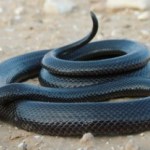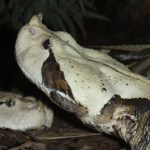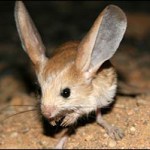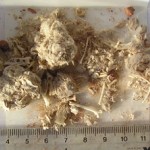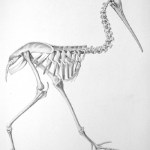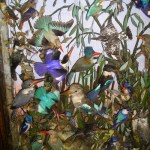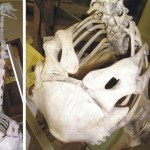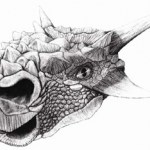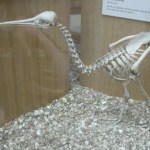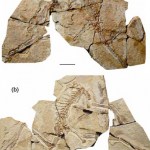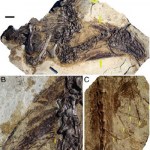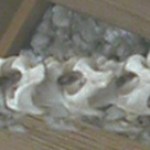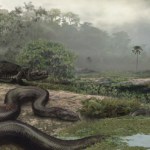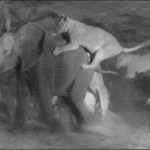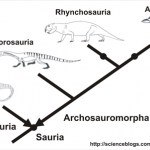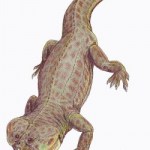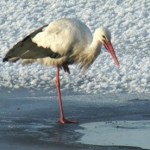
Yes, more snakes: after yesterday's horned snake article (thanks to everyone who chipped in with ideas and comments) I've decided to stick with snakes for a while. I can knock these articles up in a few minutes, and unfortunately I just don't have time at the moment to finish the backlog of planned and semi-complete articles. And I've had 'snake guilt' for a while now: for a massive tetrapod group encompassing round about 3000 extant species, snakes are still under-represented at Tet Zoo. Those of you who keep track of such things will remember the atractaspidid article, titled Side-stabbing…
Dave Hone (of Archosaur Musings and Ask A Biologist) kindly provided the photo you see here of two captive West African gaboon vipers Bitis rhinoceros (NOT East African gaboon vipers B. gabonica: see comments), and initially I was going to use it in a 'picture of the day' post. One thing led to another and what you're reading is the result. Gaboon vipers, the largest of the African viperids, are among the best known members of the genus Bitis (in which there are about 11 species). Like several other species in the genus, they're stocky, broad-headed snakes of forest floors, but other species…
More stuff from the archives... or, from Tet Zoo ver 1 anyway. The following article is about the bizarre jerboa Euchoreutes naso. Back when I wrote the article (2006), there were no photos of this species available, and I had to resort to using a single painting. However, a glut of good photos are now available, as explained below. Incidentally, do not ever google the term 'Asian wild life'.
-------------------------------------------------
It's funny how things work out. Today I am obsessed with rodents. Why? Most of my day was spent clearing out an old loft, and while rummaging through…
I picked up a lot of dead stuff in Morocco. One of the neatest things I brought back was this very large owl pellet (now broken into bits), discovered by Dave Martill at the same place where we were awoken at night by big, hooting owls assumed to have been Desert eagle owls Bubo ascalaphus [back-story here]...
As you can see (close-up below), it's stuffed full of rodent bones, at least some of which are (I think) from jerboa. So far I've only had a cursory look, but bones belonging to several individuals of more than one species are present. If and when I get round to extracting and…
While checking a few details on kiwi skeletal anatomy the other day, I discovered some old material I'd written on these strange birds. I've updated it, and here's the first lot of it.
Kiwi have been known to science since 1813. In that year George Shaw (then the Keeper of Zoology at the British Museum), writing in the final volume of his series The Naturalist's Miscellany, described a specimen that had been given to him by Captain Barclay, a privateer engaged in the transport of convicts. Investigation of Barclay's voyages reveal that he probably never visited New Zealand, so he must have…
Well, arguing about the physiology of Mesozoic archosaurs has been fun but I just can't put the time into it. Moving on, here's something entirely different...
Excuse my crappy photographic skills, and well done you if you can identify any/some/all of the species concerned. To those who don't know: yes, kookaburras (the four or so species of Dacelo) are gigantic kingfishers. We also have a few paradise kingfishers (Tanysiptera) in there, stork-billed kingfishers (Halcyon), pied kingfishers (Ceryle) and an American green kingfisher (Chloroceryle) - in all, a pretty good representation of…
Just when I'm in the middle of talking about the new dinosaurs and pterosaurs that were published in January (part I, part II, part III), February is turning out to be just as interesting. Yesterday saw the debut of the new basal sauropodomorph Panphagia protos (Martinez & Alcober 2009), and you'll know from SV-POW! that Matt Wedel's long-awaited paper on pneumatic hiatuses in sauropods recently appeared in Journal of Experimental Zoology.
Today sees the appearance of another very neat study: Leon Claessens, Pat O'Connor and David Unwin's research on respiration and pneumaticity in…
Inspired by the kiwi weirdness looked at here recently, I thought I'd focus on some other ratite skeletal stuff. But the idea here isn't to identify the animal. This is obviously the skeleton of an ostrich Struthio camelus. The question for you is a simple one: what's going on with the pectoral girdle? What makes it weird? Hmm, I wonder...
More musings on dinosaury things from January 2009. For the back-story you'll need to see part 1 and part 2, both of which are on theropods (and, specifically, on maniraptorans). This time we look at ornithischians...
One ornithischian in particular has been the subject of much discussion lately. Namely, the Upper Cretaceous Mongolian ankylosaurid
Minotaurasaurus ramachandrani Miles & Miles, 2009. This isn't such an inappropriate name - after all, the holotype specimen does have bull-like horns that project outwards from above its eyes - but it doesn't sound very euphonious... and…
Better late than never... what was the identity of that unusual string of vertebrae I featured here however-many-days-ago? Most of you realised - correctly - that it was the neck of a bird, and several of you guessed moa. This wasn't a bad guess, but it wasn't the right one. The correct answer was given three guesses in by Adam Yates of Dracovenator. Yes, it's the neck of a kiwi (Apteryx). Well done Adam, your Tet Zoo-ing skills serve you well (I'll not mention the fact that Adam's skills also extend to fishes and molluscs, gack). Why post a picture of a kiwi neck? Because it's so frikkin'…
Those of you who notice such things might have wondered where I've been over the last few days: after all, I'm now pretty much in the habit of posting to Tet Zoo every day. I've been 'absent' due to internet problems (now resolved, for the time being at least)... though, yeah, I've got other excuses too. As a result, my plans have been temporarily derailed, but I'll try and get back to speed ASAP. Meanwhile, the adjacent image shows one of the things I've been busy with this week. Would like to tell you the whole story, but can't.
More dinosaury stuff from January 2009: for the background story, please see part I.
Last time we looked at therizinosauroids. Alvarezsaurids have also been the subject of much discussion lately. This is thanks to Ceratonykus oculatus, a new taxon from the Upper Cretaceous of Mongolia (Alifanov & Barsbold 2009). Alvarezsaurids have had a slightly confusing taxonomic history. For many people, it started in 1993 with Mononykus (then called Mononychus, a name preoccupied by a beetle), first described as a bizarre flightless bird closer to modern birds than to Archaeopteryx [reconstructed…
First of all, many many thanks to everyone (both here and at SV-POW!) for the congrats regarding baby Emma. I am, shall we say, a little tired right now, but as you'll know if you've visited SV-POW! this morning, the good news as goes blogging is that I've been able to get lots of stuff prepared in advance. In theory, therefore, things won't be so different here on Tet Zoo. The one thing I haven't had time to prepare is 'the reveal' on that mystery picture from the other day, but I'll get round to that soon, thanks for your patience. Ok, to business...
I think I've said before that I tend…
I am happy to report that, at 9-43am this morning (Saturday 7th), Mrs Toni Naish gave birth to baby Emma. Things started round about 5am and, needless to say, the entire day has been taken up with baby duties. Some of you might know that southern England has been badly affected over the past week by ice and snow: a pathetic amount, but enough to prevent the movement of traffic and bring the region to its knees. Happily, our early morning journey to the hospital was uneventful and all went well. Anyway, Emma is wonderful and perfectly formed, and so far has slept an awful lot. It's fantastic…
Let's have some fun. Try and identify this tetrapod: and you have to get it down to genus. Good luck.
No time for anything new: too busy desperately trying to make money. So I'd like to bring your attention to Head et al.'s (2009) paper on the amazing new gargantuan snake Titanoboa cerrejonensis from the Palaeocene of Colombia, and also to Ed Yong's fine discussion of the paper at Not Exactly Rocket Science. Surprisingly, perhaps, Titanoboa was not a madtsoiid, but a boid related to modern anacondas and boas. The several specimens represent individuals 13 m long and perhaps 1.1 tons in weight. Staggering. For a review of pre-Titanoboa giant snakes please see Stupidly large snakes, the story…
In 2006, the second series of the BBC's Planet Earth was screened. If you saw the series, you'll know that it included a lot of awesome stuff. One thing that got an awful lot of people talking was the amazing footage - included as part of episode 2 ('Great Plains') - showing the elephant-killing lions of Savuti in Chobe National Park, northern Botswana. I wrote about this footage at Tet Zoo ver 1 back in November 2006 (it's here), and - for those who didn't see it first time round - here it is again...
While most people 'know' that elephants are immune to predation thanks to their size,…
Welcome to the third, and last, of the rhynchosaur articles. The other two are mandatory reading: part I is a general intro, part II is on jaws and teeth. This time round, we look at the form and function of the postcranial anatomy (well, predominantly at the limbs actually), and also at rhynchosaur phylogeny and at their place in the grand scheme of things [life restoration of Hyperodapedon shown above, from Benton (1983)].
We begin with the forelimb. The rhynchosaur humerus is stout, with large crests for muscle attachment and a wide, flaring distal end. The rest of the forelimb appears…
In the previous rhynchosaur article we introduced these remarkable Triassic reptiles [adjacent Hyperodapedon restoration from wikipedia]. Their amazing, specialised jaws and teeth were mentioned and discussed in passing, but I skimped on the details. Make yourself some strong coffee and be sure you're not sitting in a comfortable chair, as here's where the going gets heavy. It's a story of shearing jaws, expanding tooth fields, and maxillary grooves...
Both the maxilla and dentary in rhynchosaurs possessed more than one row of teeth. You should imagine the occlusal surfaces of these bones as…
The White stork Ciconia ciconia is a well-known migrant, moving from Europe down to Africa (either via the Iberian Peninsula or via the Middle East) during the winter. Increasingly, however, birds are choosing to over-winter in Europe. The numbers are startling: in southern France, eight birds over-wintered in 1996-1997, but 172 did so in 2003-2004 (Archaux et al. 2004).
This winter, one individual over-wintered at Lake Mjøsa, near Hamar, Norway. Nicknamed 'Sture' [shown at top of article], it scavenged at a local rubbish dump and (as of early January) was surviving night temperatures of -…
